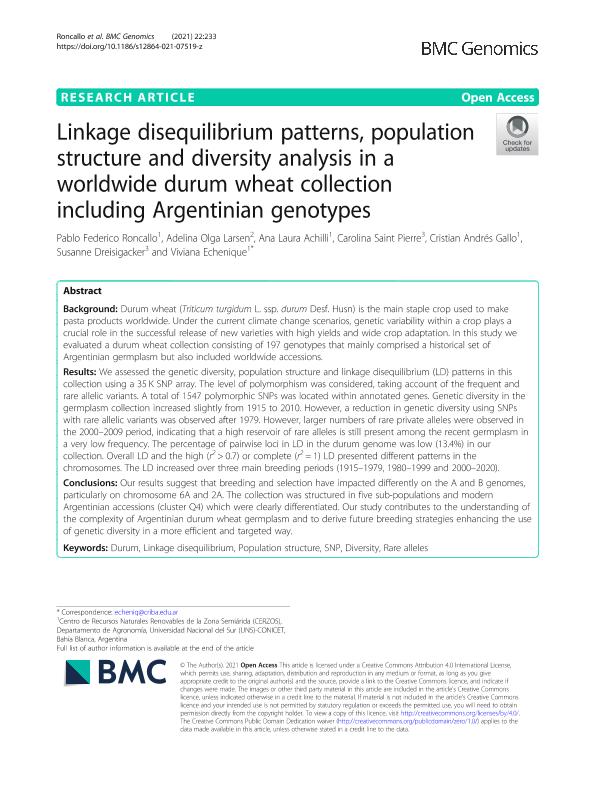Artículo
Linkage disequilibrium patterns, population structure and diversity analysis in a worldwide durum wheat collection including Argentinian genotypes
Roncallo, Pablo Federico ; Larsen, Adelina Olga; Achilli, Ana Laura
; Larsen, Adelina Olga; Achilli, Ana Laura ; Saint Pierre, Carolina; Gallo, Cristian Andrés
; Saint Pierre, Carolina; Gallo, Cristian Andrés ; Dreisigacker, Susanne; Echenique, Carmen Viviana
; Dreisigacker, Susanne; Echenique, Carmen Viviana
 ; Larsen, Adelina Olga; Achilli, Ana Laura
; Larsen, Adelina Olga; Achilli, Ana Laura ; Saint Pierre, Carolina; Gallo, Cristian Andrés
; Saint Pierre, Carolina; Gallo, Cristian Andrés ; Dreisigacker, Susanne; Echenique, Carmen Viviana
; Dreisigacker, Susanne; Echenique, Carmen Viviana
Fecha de publicación:
05/04/2021
Editorial:
BioMed Central
Revista:
BMC Genomics
ISSN:
1471-2164
Idioma:
Inglés
Tipo de recurso:
Artículo publicado
Clasificación temática:
Resumen
Background: Durum wheat (Triticum turgidum L. ssp. durum Desf. Husn) is the main staple crop used to make pasta products worldwide. Under the current climate change scenarios, genetic variability within a crop plays a crucial role in the successful release of new varieties with high yields and wide crop adaptation. In this study we evaluated a durum wheat collection consisting of 197 genotypes that mainly comprised a historical set of Argentinian germplasm but also included worldwide accessions. Results: We assessed the genetic diversity, population structure and linkage disequilibrium (LD) patterns in this collection using a 35 K SNP array. The level of polymorphism was considered, taking account of the frequent and rare allelic variants. A total of 1547 polymorphic SNPs was located within annotated genes. Genetic diversity in the germplasm collection increased slightly from 1915 to 2010. However, a reduction in genetic diversity using SNPs with rare allelic variants was observed after 1979. However, larger numbers of rare private alleles were observed in the 2000–2009 period, indicating that a high reservoir of rare alleles is still present among the recent germplasm in a very low frequency. The percentage of pairwise loci in LD in the durum genome was low (13.4%) in our collection. Overall LD and the high (r2 > 0.7) or complete (r2 = 1) LD presented different patterns in the chromosomes. The LD increased over three main breeding periods (1915–1979, 1980–1999 and 2000–2020). Conclusions: Our results suggest that breeding and selection have impacted differently on the A and B genomes, particularly on chromosome 6A and 2A. The collection was structured in five sub-populations and modern Argentinian accessions (cluster Q4) which were clearly differentiated. Our study contributes to the understanding of the complexity of Argentinian durum wheat germplasm and to derive future breeding strategies enhancing the use of genetic diversity in a more efficient and targeted way.
Palabras clave:
DIVERSITY
,
DURUM
,
LINKAGE DISEQUILIBRIUM
,
POPULATION STRUCTURE
,
RARE ALLELES
,
SNP
Archivos asociados
Licencia
Identificadores
Colecciones
Articulos(CCT - BAHIA BLANCA)
Articulos de CTRO.CIENTIFICO TECNOL.CONICET - BAHIA BLANCA
Articulos de CTRO.CIENTIFICO TECNOL.CONICET - BAHIA BLANCA
Articulos(CERZOS)
Articulos de CENTRO REC.NAT.RENOVABLES DE ZONA SEMIARIDA(I)
Articulos de CENTRO REC.NAT.RENOVABLES DE ZONA SEMIARIDA(I)
Citación
Roncallo, Pablo Federico; Larsen, Adelina Olga; Achilli, Ana Laura; Saint Pierre, Carolina; Gallo, Cristian Andrés; et al.; Linkage disequilibrium patterns, population structure and diversity analysis in a worldwide durum wheat collection including Argentinian genotypes; BioMed Central; BMC Genomics; 22; 5-4-2021; 1-17
Compartir
Altmétricas



